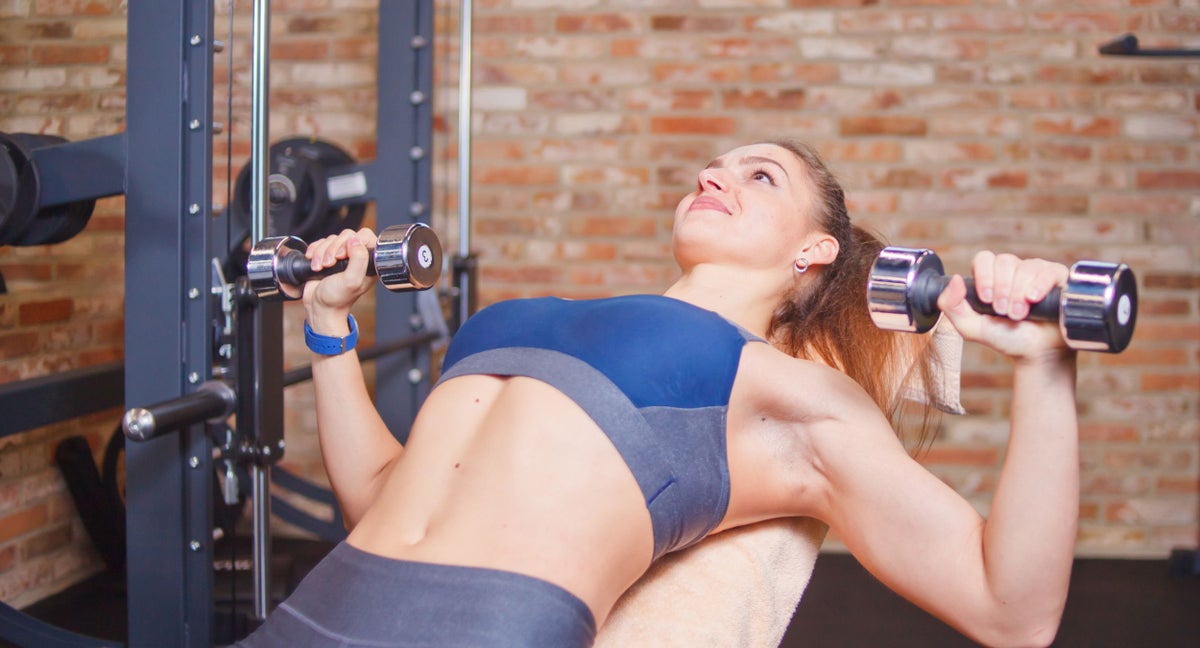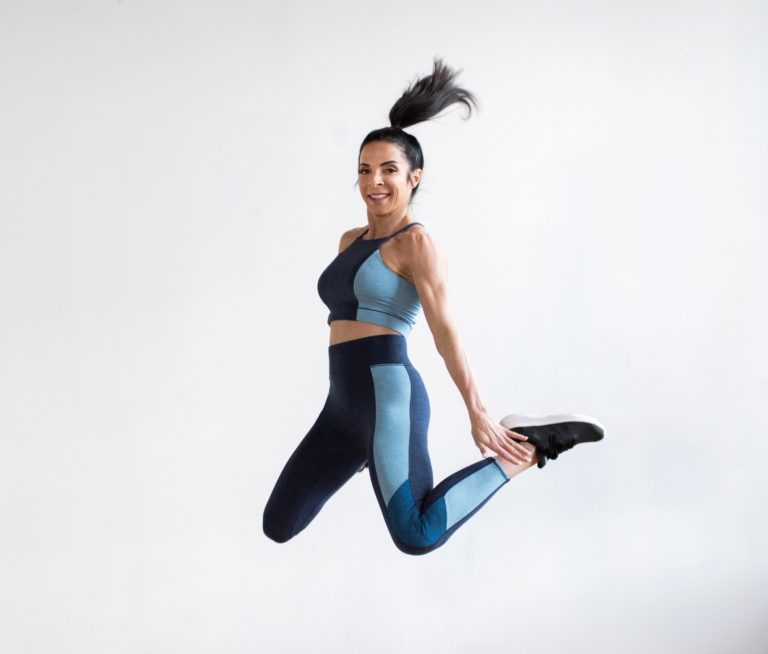
The Back-to-Basics Chest Strength Workout

When it’s time to “get back to basics” in your chest routine, there’s really only one place to logically start — that is, if you can manage to outmaneuver the throngs of guys who insist on setting up camp at this particular exercise station.
Men may overdo the classic barbell bench press (and no doubt it shows in their out-of-balance physiques and overdeveloped pectorals), but women, honestly, don’t turn to it quite enough, losing out on one of the best opportunities to dramatically reshape their chest and give their pecs a natural lift in the process.
“The bench press is the most complex and strength-focused movement you can choose for your chest, and along with an incline press, it can stimulate the muscle fibers you’re aiming for like no other option,” says Rachel Hall, NASM-CPT, fitness director of online training and nutritional coaching website Body FX.
But maximizing your overall results doesn’t end there.
“Beyond the bench press and incline press, the following workout hits all points of the chest across all planes of motion, with a focus on increasing repetitions and boosting the intensity instead of merely relying on pushing heavy weight,” Hall explains. “The benefit is that the individual is getting a truly complete and well-rounded chest workout, and not just following the lead of the guys who tend to fixate on their bench totals.”
The Back-to-Basics Chest Workout
| Exercise | Sets | Reps |
| Barbell Bench Press | 3-4* | 4-6 |
| Incline Dumbbell Press | 3 | 8-12 |
| Low-to-High Dumbbell Crossover | 3 | 8-12 |
| One-Arm Resistance-Band Flye | 3 | 10-15 |
| Push-Up With Push-Through | 3 | to failure |
*Start with two warm-up sets of eight to 12 reps with light weight before moving up to your working weight about 85 percent of your one-rep max.
Exercise How-tos
Barbell Bench Press
Hall’s How-To: “Lie faceup on a flat bench station and place your feet flat on the floor. Reach up to grasp the barbell with an overhand grip, your hands slightly wider than shoulder-width apart. Prepare yourself by tensing your core and engaging your pectorals and upper-body muscles and then, with the assistance of a spotter, unrack the bar, holding your arms straight directly above your chest. Take a deep breath in, then lower the bar under control until it comes in contact with your upper chest, keeping your wrists directly under the bar and your elbows pointing out away from your body as they bend. From the bottom position, breathe out forcefully as you press the bar back to the elbows-extended position, stopping just before full lockout. Repeat the sequence.”
Incline Dumbbell Press
Hall’s How-To: “Lie on a bench adjusted to a 45-degree angle, feet planted on the floor, holding a dumbbell in each hand just outside your shoulders. Keeping your wrists stacked directly underneath the handle and elbows pointed out away from your body, powerfully press the dumbbells toward the ceiling. Stop when the dumbbells are an inch or so away from each other above you, squeezing your pecs for a one-count, then slowly return to the start position.”
Low-to-High Dumbbell Crossover
Hall’s How-To: “Stand with a dumbbell in each hand, your chest lifted, shoulders shifted back, core tight, knees slightly bent and posture strong. Lift both arms a few inches so they are no longer at your sides, and turn your wrists so they are facing forward. From here, keeping your elbows straight but not locked out, you’ll bring both dumbbells up in an x-motion in front of your body, crossing one arm above the other and stopping when each dumbbell is extended out in front of the opposite shoulder. You’ll feel an intense contraction in your pectorals, especially the inner portion. After a pause at the top, slowly reverse direction to the start. Consider alternating which arm crosses over the top of the other on each rep, which helps ensure your pecs are receiving more equal treatment during a set.”
One-Arm Resistance-Band Flye
Hall’s How-To: “Attach one end of a resistance band to a sturdy object at shoulder level. Stand with your right shoulder closest to the anchor point and grasp the free end of the band in your right hand, elbow open and arm raised to chest height straight out to the side — at this point, the band should be somewhat taut but not tight. (Take a small step closer or away from the anchor point as needed.) From here, contract your pectorals to bring your fully extended arm across your body until it is pointing directly forward, your palm aligned with your midchest. Hold that position for a one-count, then slowly return your arm back to the start position. Repeat for 10 to 15 reps, then switch sides to repeat with the left arm.”
Push-Up With Push-Through
Hall’s How-To: “Assume a plank position, body flat from your head to your heels with your feet together and toes on the floor, and your hands wider than shoulder width and your elbows extended. Keeping your core tight and not allowing your hips to collapse toward the floor at any point during the rep, lower your torso down toward the floor as far as you can. From the bottom, forcefully reverse direction by pressing through your palms until your elbows are straight but not locked out. At the top, continue to ‘push through’ for a slightly larger total range of motion by bringing your shoulder caps forward and shifting your shoulder blades out to each side.”
Pump Up the Intensity
After a few months of “getting back to basics” in your workouts, you can start reintroducing various training techniques to make your workouts more fun and challenging. Here are a few of Rachel Hall’s favorites:
Supersets: “Pair two exercises together and perform them back-to-back with no rest in between.”
Giant Sets: “Perform three to four exercises in a row without rest. This is great for building mass. For full recovery and to make sure you have enough strength to give your all from the start to the end of your workout, at the end of your last exercise in a giant set, you should take a two- to three-minute break before moving on to the next group of exercises.”
Pyramid Sets: “For these, you’ll pick an exercise and change the weight midset — for instance, if you’re doing an incline dumbbell press, you can start with 5-pounders and do 12 reps, then switch to 8-pounders and immediately do 10 reps, then switch again to 10-pounders and perform eight reps, and finish with 12-pound dumbbells for six reps. Pyramid sets can be good at the beginning of a routine if you’re working your way up in weight or at the end of a routine if you do the reverse, lowering the weight as you increase the reps on each dumbbell change.”
Drop Sets: “Perform an exercise until you physically cannot continue, then decrease the weight and immediately continue repping out.”
Rest-Pause Sets: “Do a set until you reach physical failure, where you cannot complete another rep with good form. Rest your muscles 10 seconds and then continue the set, trying to complete as many reps as you can before reaching momentary muscle failure again.”
Published at Tue, 03 May 2022 13:28:03 -0700






